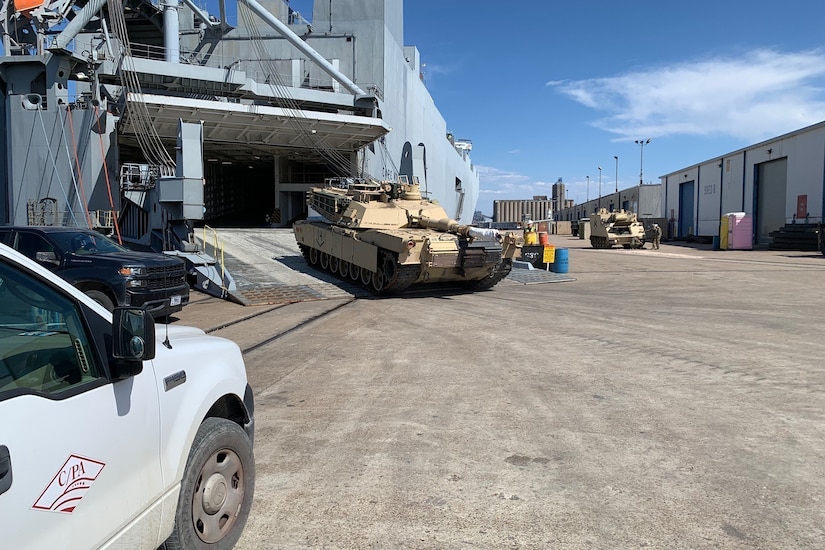The number one readiness concern of U.S. Transportation Command is sealift and air refueling, said Air Force Gen. Jacqueline D. Van Ovost, Transcom’s commander.
Van Ovost testified yesterday before the House Armed Services Committee regarding the posture of the Defense Department’s mobility enterprise and funding.
“Sealift is the backbone of our ability to deliver a decisive joint force. However, the age of the fleet is dragging readiness rates to alarming levels,” she said, noting that 17 of the 47 Ready Reserve Force ships are 50 years or older.
“To address readiness and the decreasing capacity due to the planned retirements of 27 ships in the next eight years, we must add younger ships to the fleet,” Van Ovost said.
Transcom supports the Navy’s strategy to acquire used sealift vessels from the commercial market and its request to provide the defense secretary with discretionary authority to purchase foreign-built, used ships under favorable market conditions without restrictions, she said.
“We acknowledge Congress’ intent to include domestic, new-build sealift ships to recapitalize the Ready Reserve Force, and we’re working with the Navy and the Maritime Administration to create an acquisition strategy for new construction,” she said.
The general then turned to the topic of air refueling.
“Air refueling is foundational to our nation’s power-projection advantage. It is our most stressed capability. We must ensure continuous modernization and recapitalization of the aging fleet to meet the operational requirements of the modern battlespace,” Van Ovost said.
Transcom supports the Air Force’s strategy for uninterrupted tanker recapitalization and accelerated fielding of the next generation air refueling systems, she said.
Over the past year, Transcom has made great strides diversifying its bulk fuel distribution and delivery system by having an increased forward presence with fuel afloat in contracted maritime tankers and increasing capacity and access to the U.S.-flagged maritime tanker fleet through the Tanker Security Program, she said.
Transcom fully supports the Maritime Security Program, the Jones Act and cargo preference laws that all work to ensure Transcom has the necessary U.S.-flagged capability and U.S. merchant mariners ready to move sensitive defense materials during a national emergency, she said.
Maritime stakeholders have been experiencing challenges with recruiting and retaining qualified mariners, she said.
Transcom supports MARAD and industry efforts to identify strategies that address the mariner shortage and ensure their readiness, she said.
The general also emphasized the importance of congressional reauthorization of the Foreign Intelligence Surveillance Act to protect Transcom’s logistics networks from adversaries. “The loss of this authority adds risk to my mission,” she said.
Van Ovost also told lawmakers that passing the defense supplemental funding is vital to the health of the Transportation Working Capital Fund, which preserves defense readiness.
Ann Phillips, administrator of MARAD, testified that her agency’s mission is to promote and develop the U.S. maritime industry to meet the nation’s economic and security needs.
The president’s fiscal year 2025 budget request of $859.7 million for Marad will enable the agency to continue to strengthen its sealift capability by advancing recapitalization of the Ready Reserve Force and vital commercial sealift programs that support U.S.-flagged vessels operating in foreign trade.
The 2025 budget requests $974 million from DOD budgetary authority for MARAD to acquire, upgrade and maintain vessels in the National Defense Reserve Fleet and Ready Reserve Force. “These funds will help MARAD to keep the fleet in a ready, reliable and responsive condition to ensure MARAD can meet the nation’s strategic sealift needs,” Phillips said.
The Ready Reserve Force consists of 48 vessels that are an average of over 45 years in age, and they are maintained in a reduced operating status as a result, she said.
This fleet will expand to 51 vessels by the end of the next fiscal year with the planned transfer of vessels from the Military Sealift Command. MARAD is responsible for maintaining these aging ships as part of the Navy’s Sealift Recapitalization Plan, Phillips said.
“We are actively advancing urgent recapitalization of the RRF using congressional authority to purchase vessels through a contracted vessel acquisition manager,” she said.
The 2025 budget also requests $318 million for the Maritime Security Program to support 60 commercially viable, militarily useful vessels, she said.
The budget also requests $60 million for the 10-vessel Tanker Security Program. These ships will provide DOD with reliable access to tankers, she said.
MARAD is collaborating with stakeholders to address the mariner shortage, she said.
The 2025 budget request includes $191 million to support U.S. Merchant Marine Academy operations and MARAD’s Capital Asset Management Program for the academy. It also requests $87 million to support maritime academies in six states, she said.









